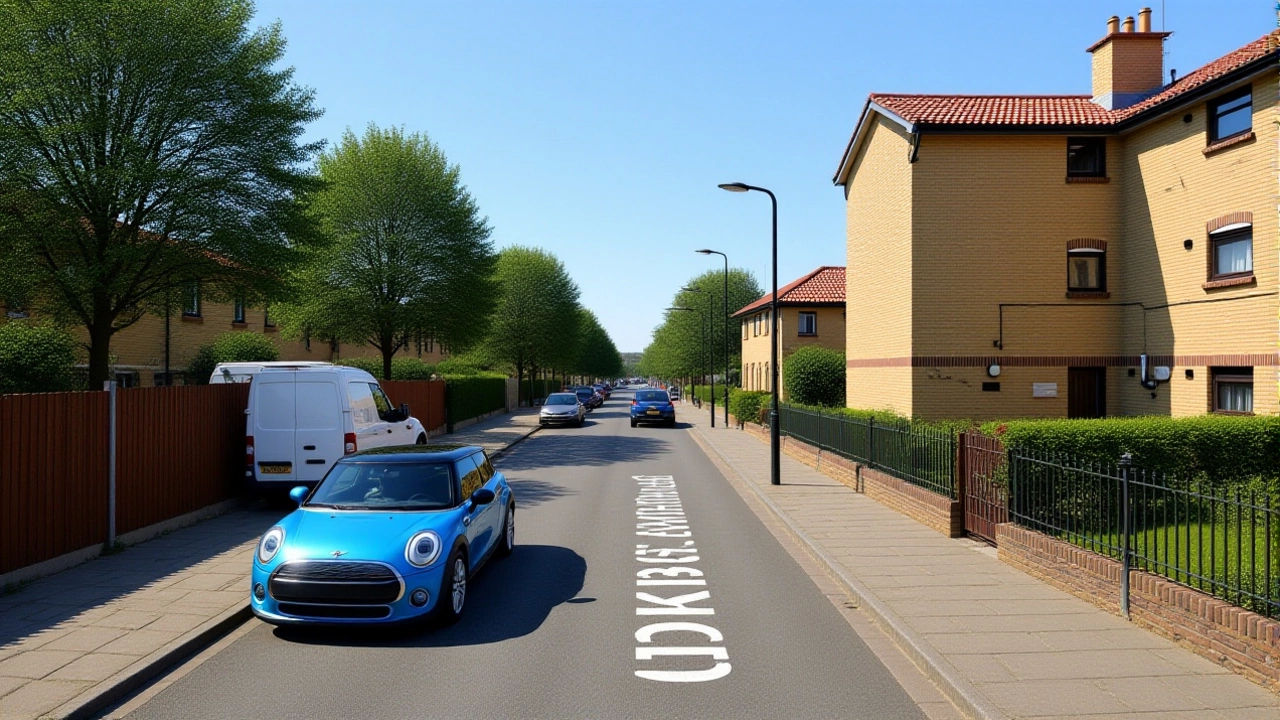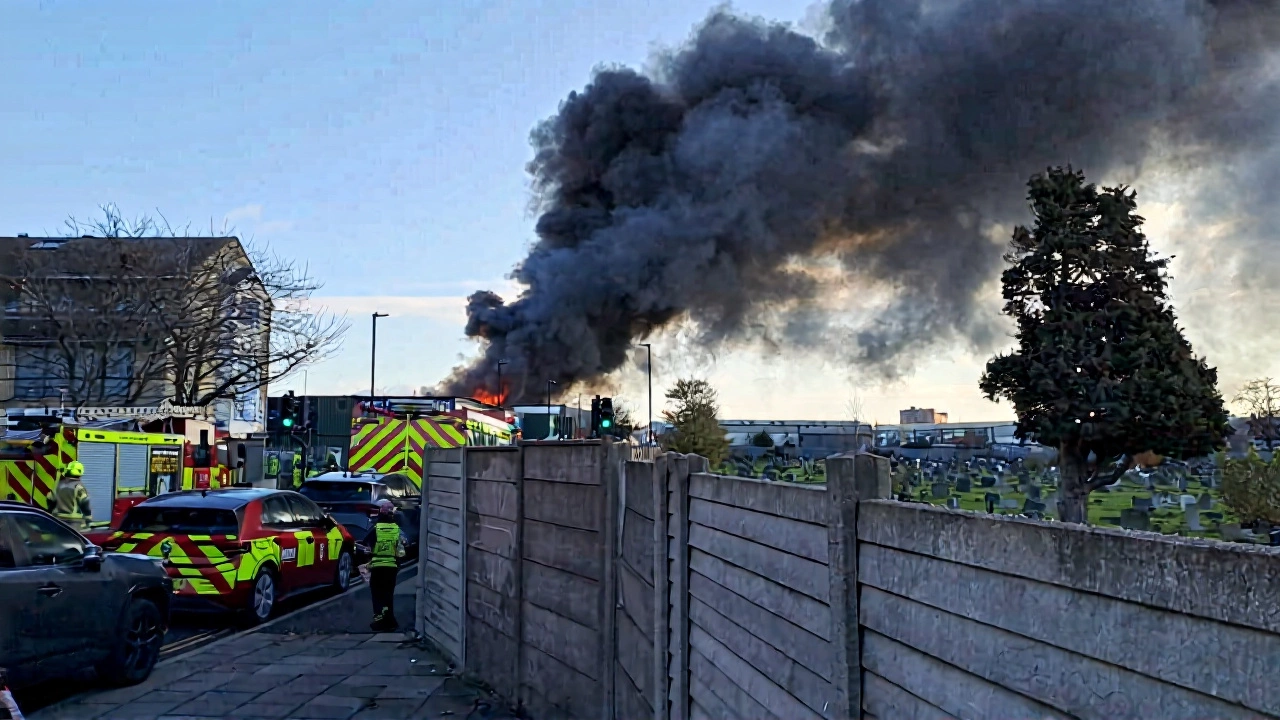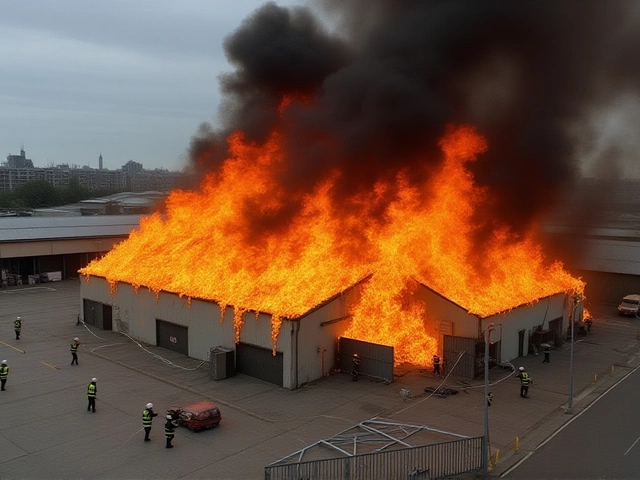At 8:55 AM on Tuesday, November 25, 2025, a massive fire ripped through a two-storey warehouse and retail complex at Middlesex Business Park on Bridge Road in Southall, West London. What began as a routine blaze quickly turned into a life-threatening emergency when multiple explosions rocked the building — caused, authorities believe, by fireworks and pressurized gas cylinders stored inside. The London Fire Brigade declared a major incident by midday, pulling all frontline crews back to a 200-meter safety zone. It was a rare, high-stakes decision: firefighters don’t retreat unless the risk of death outweighs the chance of saving property.
Explosions Force Tactical Retreat
By 11:30 AM, the roof had collapsed. Three-quarters of the building was engulfed in flames. Smoke billowed into the sky, visible for miles across west London. And then — boom. Again. And again.
"All firefighters had withdrawn after reporting explosions," said Assistant Commissioner Pat Goulbourne, the LFB’s Incident Commander on-site. "We’re now fighting the fire from a distance. Crew safety is non-negotiable."
That’s standard protocol when explosives are suspected. Firefighters don’t charge into a burning building if they know a gas cylinder might detonate behind them. But it’s unnerving for residents who watched their neighborhood turn into a war zone.
"Explosions going off," one witness told reporters. "It’s been going since about 8:55 in the morning or something."
Evacuations and Community Impact
As flames climbed higher, the Ealing Council activated emergency protocols. Three schools — including St. Mary’s Primary and Southall High — were evacuated. A residential block on Bridge Road, home to over 150 people, was cleared. Around 1,000 people were displaced. More than 100 sought refuge at the Southall Community Centre, where council staff handed out blankets, water, and snacks.
"We’re supporting residents displaced by the incident," said an Ealing Council spokesperson. "We’ve got social workers, translators, and mental health support on standby."
Residents were told to keep windows and doors shut. The smoke wasn’t just thick — it was toxic. The LFB warned of potential chemical fumes from burning plastics, electronics, and unknown stored goods. Air quality monitors in Hayes and Hanwell registered elevated particulate levels for over six hours.

Scale of the Response
The LFB deployed 150 firefighters and 25 fire engines — one of the largest single-incident responses in London this year. Three turntable ladders were positioned to spray water from above, but even that had limits. With the roof gone and walls unstable, crews couldn’t get close enough to target the fire’s core.
The London Fire Brigade, headquartered at 8 Albert Embankment, responded to over 130,000 incidents last year. But this was different. "We’ve dealt with warehouse fires before," said Goulbourne. "But not with this many unreported explosives inside."
Firefighters worked in shifts throughout the afternoon, using thermal imaging drones to map hotspots. At 6:02 PM, the major incident was officially stood down — not because the fire was out, but because the immediate danger had passed. The blaze was still burning. Crews remained on site overnight, dousing smoldering debris with foam and water.
Why This Happened — And Why It Matters
Southall has long been a hub for small industrial businesses, many operating in converted warehouses. Some store seasonal goods — including fireworks for Diwali and Guy Fawkes Night. Others handle compressed gases for welding or medical use. Regulations exist, but enforcement is patchy.
"This isn’t the first time fireworks have been stored improperly in West London," said Dr. Lena Patel, an industrial safety expert at King’s College London. "We’ve had near-misses in Brent and Hounslow. The problem? Many small operators don’t know the rules — or don’t care."
The Middlesex Business Park has 47 active units. Most are legally compliant. But one? That’s all it takes.
Fire investigators from the LFB and the Health and Safety Executive are now combing through charred remains. They’re looking for shipping manifests, CCTV footage, and any records of who rented the unit. The warehouse had been leased under a company name — but that name doesn’t appear on any official business registry.

What’s Next
The site remains cordoned off. Demolition crews may need to tear down unstable sections before cleanup can begin. The LFB says the investigation could take months. Meanwhile, Ealing Council is reviewing warehouse licensing rules in the borough.
"We’re looking at mandatory storage certifications," said a council insider. "If you’re storing fireworks or gas, you shouldn’t just be able to rent a unit and hope for the best."
Residents are angry. "We pay our taxes," said Maria Khan, who lives two streets away. "We shouldn’t have to live with this kind of risk just because someone’s cutting corners."
For now, the smoke has cleared. But the questions haven’t.
Frequently Asked Questions
Why were firefighters pulled back during the fire?
Firefighters withdrew because multiple explosions were reported inside the warehouse, strongly suggesting the presence of fireworks and pressurized gas cylinders. These materials can detonate unpredictably, making direct interior attack deadly. Standard protocol demands a 200-meter safety perimeter in such cases to protect crews — even if it means delaying fire suppression.
How many people were affected by the evacuation?
Approximately 1,000 people were displaced, including residents of a nearby block and students and staff from three schools. Over 100 individuals sought shelter at the Southall Community Centre, supported by Ealing Council with food, medical aid, and translation services. The LFB also advised all nearby residents to keep windows closed due to toxic smoke.
What’s being done to prevent this from happening again?
Ealing Council is reviewing warehouse licensing rules and considering mandatory storage certifications for hazardous materials like fireworks and gas cylinders. The Health and Safety Executive is also launching a targeted inspection campaign across industrial parks in west London, focusing on units with unregistered tenants — a key red flag in this case.
How long will the investigation take?
Fire investigators estimate the cause determination will take three to six months. They’re analyzing debris, reviewing surveillance footage from nearby businesses, and tracing the warehouse leaseholder — who appears to be operating under an unregistered business name. If negligence or illegal storage is found, criminal charges could follow.
Was the smoke dangerous to health?
Yes. The smoke contained particulate matter from burning plastics, electronics, and unknown chemicals. Air quality monitors in Hayes and Hanwell recorded levels above the WHO’s safe threshold for 6+ hours. Residents with asthma or respiratory conditions were advised to stay indoors. Public Health England is monitoring for potential long-term effects.
Is this type of fire common in London?
Not with this level of explosive risk. While warehouse fires occur regularly, the presence of unreported fireworks and gas cylinders is rare and highly unusual. Similar incidents happened in Brent in 2021 and Hounslow in 2023, but none triggered a major incident declaration. This case highlights a growing gap in enforcement for small industrial tenants in urban areas.









